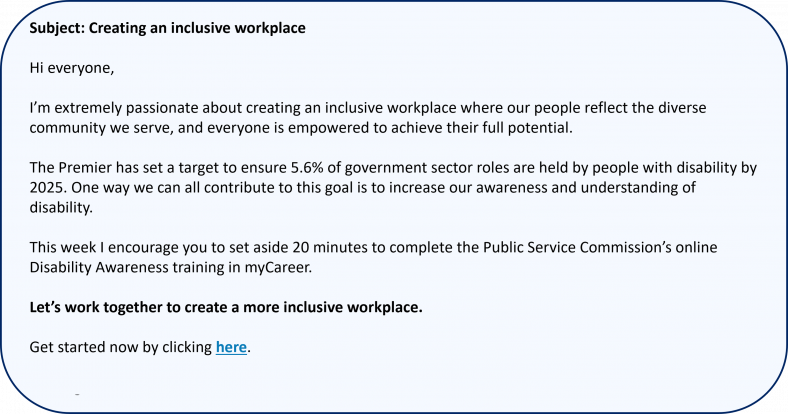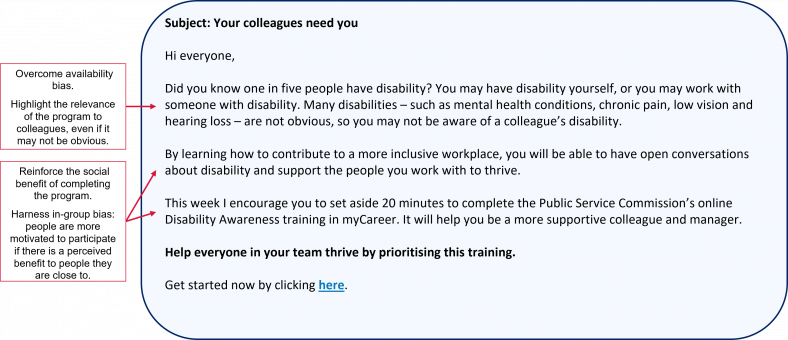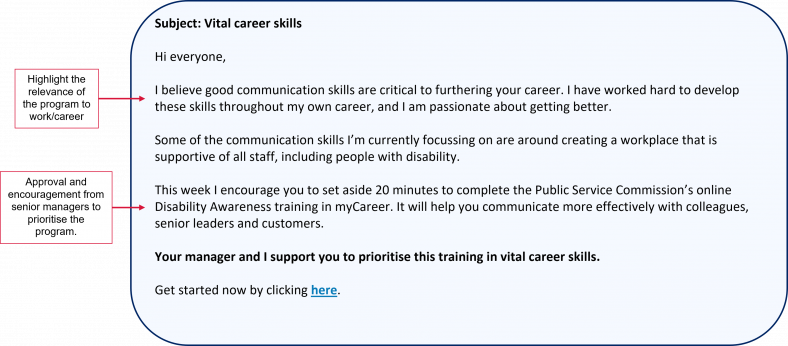Increasing take up of training in disability awareness
Engagement in diversity initiatives can drive workplace inclusion and productivity. You can prompt engagement in initiatives like training and development by developing stronger messages. This includes making messages easy to understand, using framing to grab the attention of the audience, highlighting the social impact, and timing messages strategically.

The challenge
The NSW Premier has set a target to ensure 5.6 per cent of government sector roles are held by people with disability by 2025. The Public Service Commission (PSC) has developed several initiatives to build disability awareness and confidence among all employees.
In partnership with the PSC, the NSW Behavioural Insights Unit (BIU) found that diversity initiatives such as training can help promote inclusivity – you can read more about this in our blog. However, this requires increased awareness about disability, which might be achieved through improved engagement in disability inclusion initiatives.
What we did
The BIU partnered with the PSC to run a randomized controlled trial to test the impact of communication frames on engagement with disability initiatives. We focused on a specific training course, which had a 2.1 per cent completion rate prior to the trial in 2020.
We developed three emails (a control and two intervention emails) to encourage training completion.
To boost engagement across all three emails, we:
- Made engagement easy by shortening the email content (to avoid information overload)
- Attracted attention by including a single “call to action” that allowed a click through to the training
- Made the training timely by allocating training around performance review time, when staff are primed for workplace training
- Used defaults by placing the training in the training ‘to do’ list of staff
In addition to these techniques, we altered the way the training was framed based on research on framing effects. This shows that the same information, presented in a different way, can prompt different responses. Our research suggested that two message frames could harness the motivation of the audience to complete the training, so we incorporated these into the two intervention emails:
1. Pro-social: Highlighting the benefit of training to the recipient’s colleagues.
2. Self-interest: Highlighting the benefit of training to the recipient’s career
We tested these two message frames against the third control email, which had a neutral frame but still incorporated behavioural insights principles.
Control email

Pro-social email

Self-interest email

What we found
Across all three emails 22.4 per cent of employees completed the new training during the trial period – a big jump from 2.1 per cent before the trial. There were no significant differences in completion rates between the pro-social and the self-interest message.
Interestingly, we found that pro-social and self-interest frames significantly increased training start rates compared with the control. This means that these frames were more likely to prompt training, but participants dropped out of it at a higher rate.
What does this mean? Self-interest and pro-social frames motivate action and engagement. If you’re interested in testing whether they can sustain engagement, consider weaving these motivators into the training itself. For example, to harness pro-social motivators, demonstrate how using the skills covered in training can directly benefit colleagues with disability.
What’s next
We saw a big jump in completion rates across all messages. There are a few ways you can incorporate what works into promotion of your diversity initiatives:
- Harness the power of default. Make engagement the default. For example, if encouraging engagement in training, allocate the training to staff in an online training portal.
- Simplify the message. Communications should be brief. Staff with multiple competing priorities don’t have time to read lengthy emails.
- Use a clear, strong, call to action. Limit the number of directions you provide and only have one call to action in each communication. Only include key pieces of information and make the call to action prominent.
- Link the timing with framing of the promotion of programs. Staff with competing priorities are more likely to engage with initiatives and programs at salient times. For example, use a self-interest, career-focused frame to promote training at times when staff are completing career development plans.